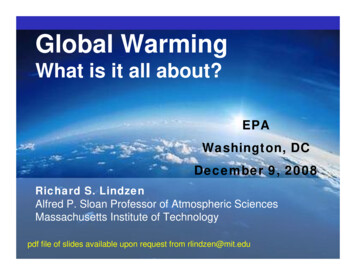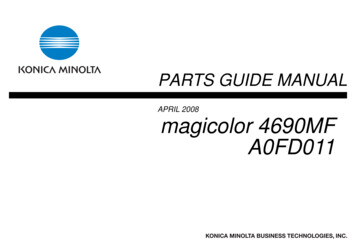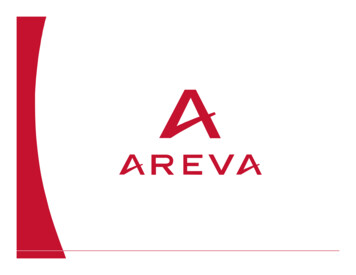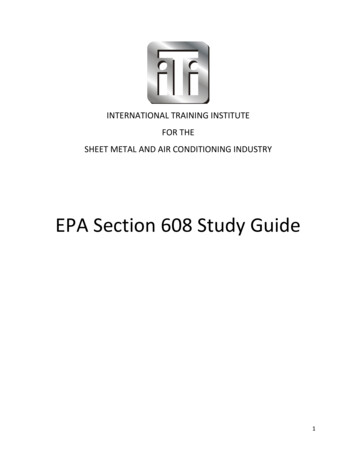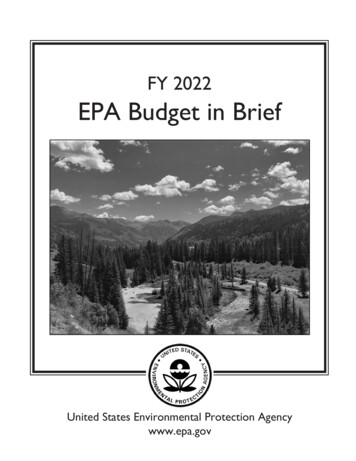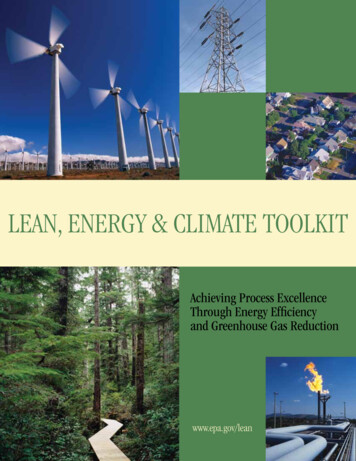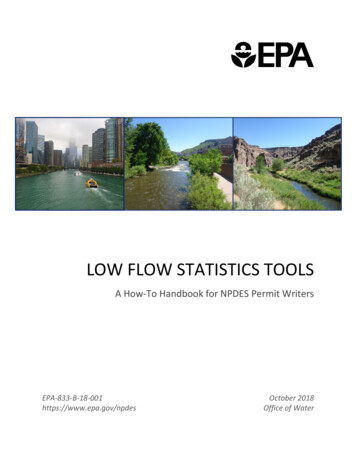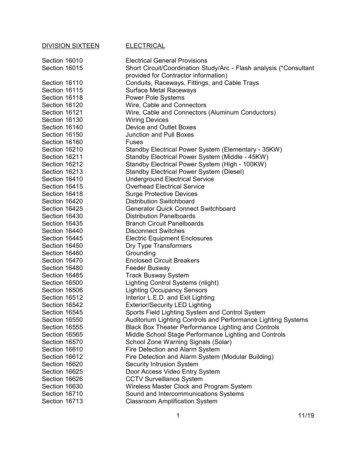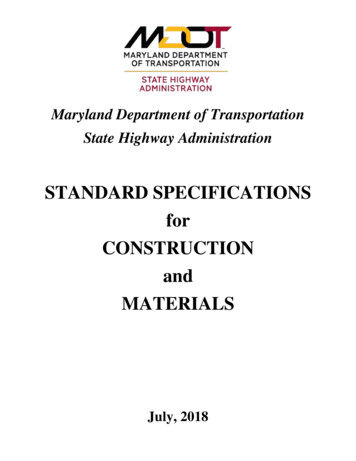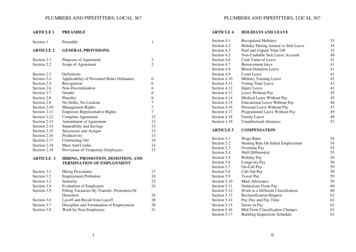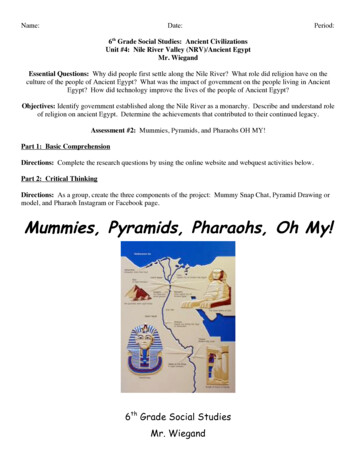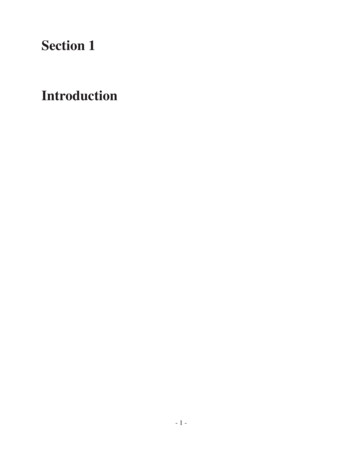
Transcription
Section 1Introduction-1-
Chapter 2Cost Estimation: Concepts and MethodologyJohn L. SorrelsThomas G. WaltonAir Economics GroupHealth and Environmental Impacts DivisionOffice of Air Quality Planning and StandardsU.S. Environmental Protection AgencyResearch Triangle Park, NC 27711November 2017-2-
Contents2.1 Introduction .2-42.2 Private versus Social Cost .2-42.3 Types of Cost Estimates .2-52.4 Cost Categories Defined .2-82.4.1 Elements of Total Capital Investment .2-82.4.2 Elements of Total Annual Cost.2-122.5 Financial Concepts .2-142.5.1 Time Frame .2-142.5.2 Interest Rates .2-142.5.3 Prices and Inflation .2-162.5.4 Financial Analysis .2-192.5.4.1 Net Present Value .2-192.5.4.2 Equivalent Uniform Annual Cost and Annualization .2-212.6 Estimating Procedure .2-222.6.1 Facility Parameters and Regulatory Options .2-232.6.2 Control System Design .2-242.6.3 Sizing the Control System .2-242.6.4 Estimating Total Capital Investment .2-252.6.4.1 General Considerations .2-252.6.4.2 Retrofit Cost Considerations .2-272.6.5 Estimating Annual Costs .2-312.6.5.1 Raw Materials .2-312.6.5.2 Labor.2-3262.6.5.3 Maintenance Materials .2-332.6.5.4 Utilities .2-332.6.5.5 Waste Treatment and Disposal .2-332.6.5.6 Replacement Materials .2-342.6.5.7 Overhead .2-352.6.5.8 Property Taxes, Insurance, and Administrative Charges .2-352.7 Example .2-36References .2-40APPENDIX A .2-42-3-
2.1IntroductionThis chapter presents a methodology that will enable the user, having knowledge of thesource being controlled, to produce study-level estimates of the costs incurred by regulated entitiesfor a control system applied to that source. The methodology, which applies to each of the controlsystems included in this Manual, is general enough to be used with other “add-on” systems as well.Further, the methodology can apply to estimating the costs of fugitive emission controls and othernon-stack abatement methods.There are several types of users for this Manual. Industrial users are the most common,but State, local, other officials, and other environmental stakeholders (e.g., environmental groups)are other users of the Manual. EPA strongly recommends that the methodology in this Manual befollowed as part of compliance with various Clean Air Act programs.The cost estimation methodology can be used in the development of assessing privatecompliance decisions/strategies or effects of permits as various alternatives are considered. If theregulation or permit prescribes a particular control technology (e.g., installation of a scrubber),then the costs of individual controls can be estimated for affected entities. If the regulation orpermit establishes performance standards, with flexibility as to how the standards can be achieved,then the cost estimation methods can be used to estimate the costs of various options for achievingthe standards.We note that these cost estimation procedures are meant to support the calculation of thecosts of purchasing and installing pollution control equipment, and then operating and maintainingthis equipment, at a facility. Such costs are private costs because they reflect the private choicesand decisions of the owners and operators of the facilities. Broader costs associated with theinstallation and operation of pollution control equipment, such as impacts on society (e.g., changesin prices to consumers due to the impact on a producer from additional pollution control) areanalyzed using methods that assess the social costs of regulatory intervention.Again, the methods provided in this Manual is to aid in assessing private choices thatregulated entities may undertake in complying with regulation. Analyzing private decisions andthe associated costs are important in and of itself and can be used as inputs to assessing the likelyeffects of regulations. In other words, the cost estimation methodology in this Manual is meantfor private cost estimation, not social cost estimation. Information on social cost estimation canbe found in the EPA Economic Guidelines and the U.S. Office of Management and Budget’sCircular A-4. This Manual is not intended to assess the likely effects of federal regulations tosociety, but is intended to provide assessment of private actions which can be inputs to socialimpacts analysis.Users with the role of developing or reviewing compliance plans can use this Manual toestimate private costs of installing and operating control equipment. Regulated entities facingregulation can use this Manual to help decide how to comply with the requirements they are facing.-4-
2.2Private Versus Social CostsBefore delving deeper into a discussion on estimating private costs, identifying thedifferences between private and social costs is important. The Manual focuses on private cost,which refers to the costs borne by a private entity for an action the private entity decides. Forexample, if the private entity pays for the cost of installing and operating pollution controlequipment, among many options available to the entity, the entirety of these costs would beconsidered private costs.The EPA’s Guidelines for Preparing Economic Analysis define social cost as follows:“Social cost represents the total burden a regulation will impose on the economy; it can be definedas the sum of all opportunity costs incurred as a result of a regulation. These opportunity costsconsist of the value lost to society of all the goods and services that will not be produced andconsumed if firms comply with the regulation and reallocate resources away from productionactivities and towards pollution abatement. To be complete, an estimate of social cost shouldinclude both the opportunity costs of current consumption that will be forgone as a result of theregulation, and the losses that may result if the regulation reduces capital investment and thusfuture consumption.”1The term social cost refers to the overall cost of an action to society, not just to the privateentity that incurs the expense to control pollution. Social cost is based on the concept ofopportunity cost, the value associated with production and consumption that are reduced orchanged as a result of reallocating resources to reduce pollution.Assessing private cost is more straightforward because it attempts to tally up expenses thatindividual entities or facilities incur to purchase, finance, and operate pollution abatementequipment or strategies. Suppose a state government wanted to encourage pollution control for acertain industry and provided grants to pay half of the costs of a scrubber. The private cost for theindustry would be 50% of the cost of a scrubber. Using another example, suppose a firm purchasesequipment, pays sales tax on the item, and receives an immediate tax rebate. The private cost tothe firm is the sum of the equipment price plus the sales tax amount minus the excise tax amount.The estimation of private costs is the focus of the cost estimation procedures and data inthis Manual. Both EPA and OMB have developed guidance on methods appropriate for use inestimating social costs for regulatory impact analysis or economic impact analysis where the socialcosts of government interventions are assessed. The guidelines presented in this Manual are notsuitable in conducting regulatory impact analysis or economic impact analysis where the socialcosts of government interventions are assessed. Because this Manual focuses on private costs tofacilities of installing and operating pollution control equipment, we will not present the1U.S. Environmental Protection Agency, Office of Policy, National Center for Environmental Economics.Guidelines for Preparing Analysis. May 2014. Pp. 8-1 – 8-2.-5-
methodologies for social cost calculations. For more information on social cost estimationmethods, please see EPA’s Economics Guidelines [5] and OMB Circular A-4 [6].2.3Types of Cost EstimatesAs mentioned in Chapter 1.1, the costs and estimating methodology in this Manual aredirected toward the “study” estimate with a probable error of 30% percent. According to Perry’sChemical Engineer’s Handbook, a study estimate is “ used to estimate the economic feasibilityof a project before expending significant funds for piloting, marketing, land surveys, andacquisition [I]t can be prepared at relatively low cost with minimum data.” [1] The accuracy ofthe study-level estimate is consistent with that for a Class 4 cost estimate as defined by theAssociation for Advancement of Cost Engineering International (AACEI), which AACEI definesas a “study or feasibility”-level estimate. [2]Specifically, to develop a study estimate, the following must be known: Location of the plant; Location of the source within the plant; Design parameters, such as source size or capacity rating, uncontrolled pollutantconcentrations, pollutant removal requirements, etc. Rough sketch of the process flow sheet (i.e., the relative locations of the equipment inthe system); Preliminary sizes of, and material specifications for, the system equipment items; Approximate sizes and types of construction of any buildings required to house thecontrol system; Rough estimates of utility requirements (e.g. electricity, steam, water, and wastedisposal); Quantity and cost materials consumed in the process (e.g., water, reagents, andcatalyst); Preliminary flow sheet and specifications for ducts and piping; Approximate sizes ofmotors required; Economic parameters (e.g. annual interest rate, equipment life, cost year, and taxes.)[1]Besides the labor requirements for construction and operation of a project, the user willneed an estimate of the labor hours required for engineering and drafting activities because theaccuracy of an estimate (study or otherwise) depends on the amount of engineering work expendedon the project. There are four other types of estimates, three of which are more accurate than thestudy estimate. Figure 2.1 below displays the relative accuracy of each type of cost estimationprocess. The other processes are: [1] Order-of-magnitude. This estimate provides “a rule-of-thumb procedure applied onlyto repetitive types of plant installations for which there exists good cost history.” Its-6-
probable error bounds are greater than 30%. (However, according to Perry’s, “ nolimits of accuracy can safely be applied to it.”) The sole input required for making thislevel of estimate is the control system’s capacity (often measured by the maximumvolumetric flow rate of the gas passing through the system).Scope, Budget Authorization, or Preliminary. This estimate, with probable error of20%, requires more detailed knowledge than the study estimate regarding the site,flow sheet, equipment, buildings, etc. In addition, rough specifications for theinsulation and instrumentation are also needed.Project Control or Definitive. This estimate, with a probable error of 10%, requires yetmore information than the scope estimates, especially concerning the site, equipment,and electrical requirements.Firm, Contractor’s, or Detailed. This is the most accurate (probable error of 5%) of theestimate types, requiring complete drawings, specifications, and site surveys.Consequently, detailed cost estimates are typically not available until right beforeconstruction, since “time seldom permits the preparation of such estimates prior to anapproval to proceed with the project.”[1]ACCURACY 0% 5%PostDetailedConstructionReports 10 %ProjectControl 20 % 30 %ScopingStudyOrder of MagnitudeFigure 2.1: The Continuum of Accuracy for Cost AnalysesThese error bands are attempts at assessing the probable errors associated with eachestimation method based on past practices of the engineering cost-estimation discipline. However,the error bands do not shed any light on the distribution of the likely errors. The users of thisManual should not draw conclusions about probable errors that this Manual does not intend.Study-level estimates represent a compromise between the less accurate order-ofmagnitude estimates and the more accurate estimate types. The former is too imprecise to be ofmuch value in the context of pollution control installation and operation, while the latter are veryexpensive for an entity to prepare, and require detailed site- and process-specific knowledge thatsome Manual users are unlikely to have. Over time, this Manual has become the standard for airpollution control costing methodologies for many State regulatory agencies. For example, Virginiarequires that the Manual be used in making cost estimates for BACT and other permit applications,unless the permit applicant can provide convincing proof that another cost reference should be-7-
used. 2 Texas accepts the Manual methodology “as a sound source for the quantitative costanalysis” for BACT analyses it reviews.3The industrial user is more likely to have site-specific and detailed information than theaverage cost and sizing information used in a study estimate. The methodology laid out in thisManual can provide cost estimates that are more accurate when using detailed site-specificinformation. The anecdotal evidence from most testimonials volunteered by industrial usersindicates that much greater accuracy than 30 percent probable error can be attained. However,this Manual does not assume that detailed site-specific information will always be available toestimate costs associated with installing and operating pollution abatement equipment at a muchhigher accuracy level. This Manual retains the conclusion that the cost methodology laid out inthis chapter and information in each control measure chapter with 30% probable error is relevantto be used in air pollution control cost estimation for permitting actions. It is the affected industrysource that bears the burden of providing information of sufficient quality that will yield costestimates of at least a study-level estimate for permitting decisions pertaining to their facilities.2.4Cost Categories DefinedThe terminology addressing cost categories used in the earlier editions of this Manual wasadapted from the AACEI. [2]. However, different disciplines give different names to the same costcomponents, and the objective of this edition is to reach out to a broader scientific audience. Forexample, engineers determine a series of equal payments over a long period of time that fully fundsa capital project (and its operations and maintenance) by multiplying the present value of thosecosts by a capital recovery factor, which produces an Equivalent Uniform Annual Cost (EUAC)value. This is identical to the process used by accountants and financial analysts, who adjust thepresent value of the project’s cash flows to derive an annualized cost number.2.4.1 Elements of Total Capital InvestmentIn assessing the total capital investment, this Manual takes the viewpoint of an owner, thefirms making the investment, or those who have material interest in the project. Total capitalinvestment (TCI) includes all costs required to purchase equipment needed for the control system(purchased equipment costs), the costs of labor and materials for installing that equipment (directinstallation costs), costs for site preparation and buildings, and certain other costs (indirectinstallation costs). TCI also includes costs for land, working capital, and off-site facilities.4 Taxes,permitting costs, and other administrative costs are covered in Section 2.6.5.8. Financing costs2State of Virginia, Department of Environmental Quality. Draft PSD Guidelines, August 4, 2011. Pp. 4-4 to 4-5.Texas Commission on Environmental Quality. Air Permits Division. Air Permit Reviewer Reference Guide,APDG 6110. Appendix G. p. 45. January 2011.4Estimates of TCI for some control measures may not necessarily be calculated in this way due to availabilityof public information on capital investment costs and equations for those measures, such as the SNCR and SCRchapters in this Manual.3-8-
are covered in Sections 2.5.3 and 2.5.4. Foregone revenue associated with facility shut downs arecovered in Section 2.6.4.2.Direct installation costs include costs for foundations and supports, erecting and handlingthe equipment, electrical work, piping, insulation, and painting. Indirect installation costs includesuch costs as engineering costs; construction and field expenses (i.e., costs for constructionsupervisory personnel, office personnel, rental of temporary offices, etc.); contractor fees (forconstruction and engineering firms involved in the project); start-up and performance test costs (toget the control system running and to verify that it meets performance guarantees); andcontingencies. Another item within owner’s costs, technology royalties, is not separately includedwith the Manual’s methodology because technology royalties are assumed to be reflected withinthe purchased equipment costs. Contingencies is a catch-all category that covers unforeseen coststhat may arise, such as “ possible redesign and modification of equipment, escalation increasesin cost of equipment, increases in field labor costs, and delays encountered in start-up.” [2]Contingencies are discussed in more detail later in this chapter. Contingencies are not the samething as uncertainty and retrofit factor costs, which are treated separately in this chapter. Escalationis not treated as part of contingencies. Please refer to section 2.6.4 for further discussion.The elements of TCI are displayed in Figure 2.2. Note that the sum of the purchasedequipment cost, direct and indirect installation costs, site preparation, and buildings costscomprises the battery limits estimate. A battery limit is the geographic boundary defining thecoverage of a specific project [3]. Usually this encompasses all equipment of interest (in thiscase, the pollution control equipment), but excluding provision of storage, utilities,administrative buildings, or auxiliary facilities unless so specified [3]. This estimate wouldmainly apply to control systems installed in existing plants, though it could also apply to thosesystems installed in new plants when no special facilities for supporting the control system (i.e.,off-site facilities) would be required. Off-site facilities include units to produce steam, electricity,and treated water; laboratory buildings; and railroad spurs, roads, and other transportationinfrastructure items. Some pollution control systems do not generally have off-site capital unitsdedicated to them since these pollution control devices rarely consume energy at that level.However, it may be necessary—especially in the case of control systems installed in new or“grass roots” plants—for extra capacity to be built into the site generating plant to service thesystem. For example, installation of a venturi scrubber, which often requires large amounts ofelectricity, would require including costs associated with off-site facilities.Note, however, that the capital cost of a device does not include routine utility costs(which can include the cost of steam, electricity, process and cooling water, compressed air,refrigeration, waste treatment and disposal, and fuel), even if the device were to require an offsitefacility. Utility costs are categorized as operating costs that covers both the investment andoperating and maintenance costs for the utility. The utility costs associated with start-upoperations are included in the “Start-Up” component of the indirect installation costs. Operatingcosts are discussed in greater detail below. In addition, not every air pollution control systeminstallation will have all of the elements for its TCI that are listed below (e.g., buildings).-9-
eaTypically factored from the sum of the primary control device and auxiliary equipment costs.Typically factored from the purchases equipment cost.cUsually required only at “grass roots” installations.dUnlike the other direct and indirect costs, costs for these items usually are not factored from the purchased equipmentcost. Rather, they are sized and costed separately.eNormally not required with add-on control systems.bFigure 2.2: Elements of Total Capital InvestmentAs Figure 2.2 shows, the installation of pollution control equipment may also require land,but since some add-on control systems take up very little space (often a quarter-acre or less), thiscost may be relatively small. Certain control systems, such as those used for flue gasdesulfurization (FGD) or selective catalytic reduction (SCR), require larger quantities of land forthe equipment, chemicals storage, and waste disposal. In these cases, especially when performinga retrofit installation, space constraints can significantly influence the cost of installation, and thepurchase of additional land and remediation of existing land and property may be a significantfactor in the development of the project’s capital costs.- 10 -
However, land is not treated the same as other capital investments, since it is notdepreciated for accounting purposes. The value of the land may fluctuate depending on the marketconditions, but for accounting purposes and assessing private costs, land is not depreciated. Thepurchase price of new land needed for siting a pollution control device can be added to the TCI,but it must not be depreciated. If the firm plans on dismantling the device at some future time, thevalue of the land should be included at the disposal point as an “income” to the project to net itout of the cash flow analysis (more on cash flow analysis later, in section 2.5.4).One might expect initial operational costs (the initial costs of fuel, chemicals, and othermaterials, as well as labor and maintenance related to start-up) to be included in the operatingcost section of the cost analysis instead of in the capital component, but such an allocation wouldbe inappropriate. Routine operation of the control does not begin until the system has beentested, balanced, and adjusted to work within its design parameters. Until then, all utilitiesconsumed, all labor expended, and all maintenance and repairs performed are a part of theconstruction phase of the project and are included in the TCI in the “Start-Up” component of theindirect installation costs.In addition, the TCI of controls for sources that affect fan capacity (e.g., FGD scrubbers,SCRs) may be impacted by the unit’s elevation with respect to sea level. Cost calculations for thecontrol measures within the Manual have typically been developed for systems located at sea level.For systems located at higher elevations (generally over 500 feet above sea level), the purchasedequipment cost and balance of plant cost should be increased based on the ratio of the atmosphericpressure between sea level and the location of the system, i.e., atmospheric pressure at sea leveldivided by atmospheric pressure at the elevation of the unit.5The method for estimating TCI in this Manual is an “overnight” estimation method. Thismethod estimates capital cost as if no interest was incurred during construction and thereforeestimates capital cost as if the project is completed “overnight.” An alternate way of describingthis method is the present value cost that would have to be paid as a lump sum up front tocompletely pay for a construction project. Cost items such as Allowance for Funds Used DuringConstruction (AFUDC), which is defined as the costs of debt and equity funds used to financeplant construction, and is an amount credited on the firm’s statement of income and charged toconstruction in progress on the firm’s balance sheet, is treated separately in Section 2.5.3 in thisManual. This item is an estimate that is incurred over the timespan of construction. Forexample, this is considered as a cost item within the electric power industry.6 [15] Other costitems similarly treated separately include escalation of costs to a future year due to inflation inSection 2.5.4. We provide more discussion later in this chapter on these cost items that are notincluded in this section.5One instance of this is the estimates of costs for the recently revised SNCR and SCR Control Cost Manualchapters, which are available at http://www.epa.gov/ttn/ecas/costmodels.html.6See the National Energy Technology Laboratory’s “Quality Guidelines for Energy System Studies: CostEstimation Methodology for NETL Assessments of Power Plant Performance.”- 11 -
2.4.2Elements of Total CostTotal Cost (TC) refers to costs that are incurred yearly. TC has three elements: direct costs(DC), indirect costs (IC), and recovery credits (RC), which are related by the following equation:TC DC IC RC(2.1)The basis of direct costs and recovery credits is one year, as this period allows for seasonalvariations in production (and emissions generation) and is directly usable in financial analyses.(See Section 2.3.) [4] The various annual costs and their interrelationships are displayed in Figure2.3. Some indirect costs are not incurred on an annual basis. Purchase, installation, and start-upof pollution abatement capital equipment often take multiple years. To incorporate these multiyear costs with other annual costs, the capital costs are amortized and converted into capitalrecovery. If the timing between direct costs and indirect costs are different, then an alternativeapproach for estimating total cost is to calculate the present value of these costs before summingthem.Variable costs are those that vary with some measure of productivity - generally thecompany’s productive output. But for our purposes, the proper metric may be the quantity ofexhaust gas processed by the control system per unit time. Semi-variable costs also vary with somemeasure of production, but have a positive cost even when production is zero.An example would be a boiler producing process steam for only sixteen hours a day. Duringthe time the boiler is idle, it costs less to keep the boiler running at some idle level than to re-heatit at the beginning of the next shift. Consequently, that idle level operation cannot be attributed toproduction and should be considered the fixed component o
2.2 Private Versus Social Costs Before delving deeper into a discussion on estimating private costs, identifying the differences between private and social costs is important. The Manual focuses on private cost, which refers to the costs borne by a pri
